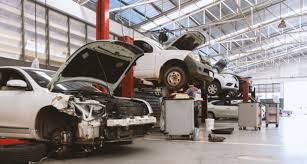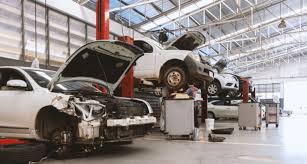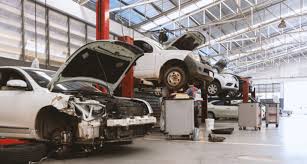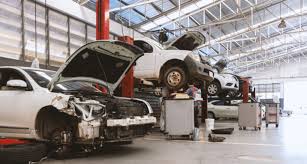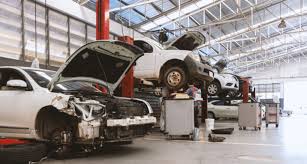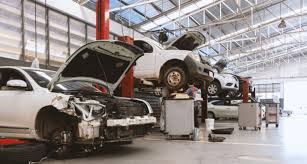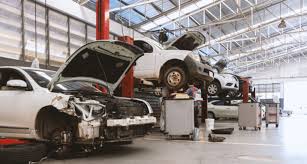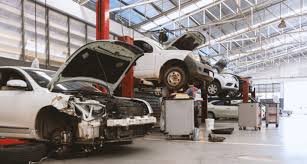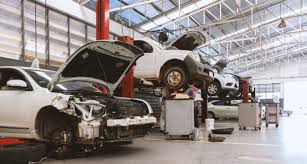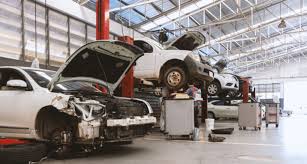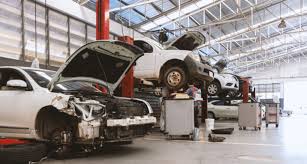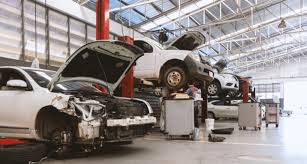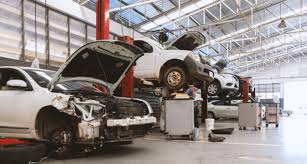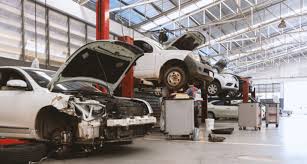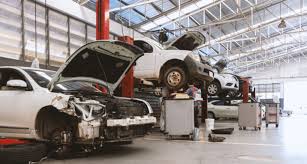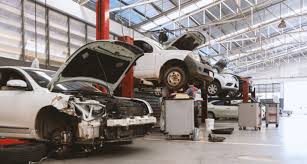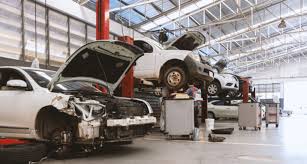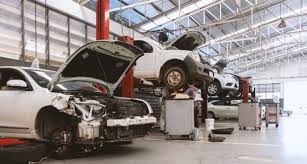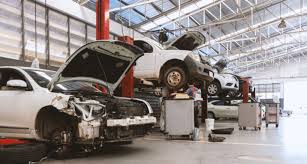Car Body Shop Fire Insurance: Paint Booth & Chemical Fire Protection
Running a car body shop involves working with highly flammable materials, volatile chemicals, and sophisticated equipment that can pose significant fire risks. From paint booths filled with combustible vapors to storage areas packed with solvents and thinners, car body shops face unique fire hazards that require specialized insurance protection. Understanding these risks and securing appropriate fire insurance coverage is crucial for protecting your business, employees, and customers.
Understanding Fire Risks in Car Body Shops
Car body shops operate in environments where fire hazards are ever-present. The combination of flammable paints, solvents, adhesives, and electrical equipment creates a perfect storm for potential fire incidents. Paint booths, in particular, represent one of the highest risk areas due to the concentration of volatile organic compounds (VOCs) and the presence of ignition sources.
The automotive refinishing process involves multiple stages where fire risks escalate. During preparation, sanding dust can become airborne and potentially ignitable. The painting process introduces atomized paint particles and solvent vapors into the air, creating an explosive atmosphere if proper ventilation fails. Curing processes often involve elevated temperatures that can ignite nearby combustible materials if safety protocols aren't followed.
Chemical storage areas present another significant fire risk. Body shops typically store large quantities of paints, thinners, reducers, and cleaning solvents. These materials can ignite from various sources including electrical faults, static electricity, or human error. The rapid spread of chemical fires can devastate entire facilities within minutes, making prevention and proper insurance coverage essential.
Paint Booth Fire Hazards and Protection
Paint booths are the heart of any car body shop operation, but they're also the most fire-prone areas. These enclosed spaces concentrate flammable vapors and particles while introducing potential ignition sources through electrical equipment and heating elements. Understanding paint booth fire risks is crucial for both prevention and insurance purposes.
Modern paint booths incorporate numerous safety features including explosion-proof lighting, proper ventilation systems, and fire suppression equipment. However, these systems can fail or be compromised through poor maintenance or operator error. Overspray buildup on walls and filters creates additional fuel for fires, while malfunctioning exhaust fans can allow dangerous vapor concentrations to accumulate.
The types of fires that can occur in paint booths vary significantly. Flash fires from ignited vapors can spread rapidly throughout the booth and into connected ventilation systems. Electrical fires from faulty wiring or overloaded circuits can ignite surrounding combustible materials. Heat-related fires from malfunctioning curing equipment can slowly build before erupting into major incidents.
Fire suppression systems in paint booths typically include automatic sprinkler systems, foam suppression systems, or specialized chemical suppression systems. Each type offers different advantages and limitations. Water-based systems are effective for general fires but may not be suitable for chemical fires. Foam systems can smother flammable liquid fires but require proper maintenance to remain effective. Chemical suppression systems offer rapid response but can be expensive to install and maintain.
Chemical Fire Risks and Mitigation
The chemicals used in car body shops present unique fire challenges that differ from ordinary combustible materials. Solvents, thinners, and paint products can ignite at relatively low temperatures and burn with intense heat. Understanding these chemical fire risks is essential for proper insurance coverage and risk management.
Solvent-based products are particularly dangerous because they produce vapors that are heavier than air and can travel significant distances before encountering an ignition source. These vapors can accumulate in low-lying areas, creating invisible fire hazards. Flash points for common automotive chemicals range from extremely low temperatures to moderately elevated levels, meaning fires can ignite under normal working conditions.
Chemical fires often burn differently than ordinary fires, producing toxic fumes and requiring specialized extinguishing agents. Water may not be effective and can actually spread some chemical fires. Carbon dioxide systems can displace oxygen but may not cool burning chemicals sufficiently. Dry chemical systems are often most effective but can create cleanup challenges and equipment damage.
Proper chemical storage is crucial for fire prevention. Segregating incompatible chemicals, maintaining proper ventilation, controlling ignition sources, and implementing spill containment measures all reduce fire risks. However, even with proper precautions, chemical fires can occur, making comprehensive insurance coverage essential.
Types of Fire Insurance Coverage
Fire insurance for car body shops must address the unique risks associated with paint booth operations and chemical storage. Standard commercial property insurance may not provide adequate coverage for specialized equipment and chemical-related losses. Understanding the different types of fire insurance coverage available helps ensure comprehensive protection.
Building and contents coverage forms the foundation of fire insurance protection. This coverage protects the physical structure of your facility and the contents within it. For car body shops, this includes paint booths, spray equipment, compressors, and inventory. However, standard policies may have limitations on coverage for certain types of equipment or chemicals.
Business interruption coverage is crucial for car body shops because fire damage often requires extended closure periods. Paint booth fires can necessitate complete facility decontamination and equipment replacement, potentially keeping businesses closed for weeks or months. This coverage helps replace lost income and covers ongoing expenses during the restoration period.
Equipment breakdown coverage specifically addresses mechanical failures that can lead to fires. Paint booth ventilation systems, compressors, and electrical equipment are all susceptible to breakdowns that can cause fires. This coverage helps repair or replace failed equipment and may cover resulting fire damage.
Pollution liability coverage addresses environmental contamination that can result from chemical fires. When chemicals burn, they can create toxic residues that contaminate soil, groundwater, or air. Cleanup costs can be substantial, and standard fire insurance may not cover these environmental remediation expenses.
Specialized Paint Booth Insurance
Paint booths require specialized insurance considerations due to their unique construction, operation, and fire risks. Standard commercial property policies may not adequately address the specific needs of paint booth operations, making specialized coverage essential.
Paint booth equipment represents a significant investment that requires proper valuation for insurance purposes. Modern paint booths can cost hundreds of thousands of dollars and include sophisticated ventilation systems, lighting, and control equipment. Replacement cost coverage ensures that damaged equipment can be replaced with similar new equipment rather than depreciated value.
Installation and commissioning costs for paint booth equipment can be substantial and may not be covered under standard policies. When fire damage occurs, replacement equipment must be properly installed, tested, and commissioned before use. These costs can add significantly to total loss amounts and should be specifically addressed in insurance policies.
Decontamination costs following paint booth fires can be extensive. Chemical residues from fires may contaminate the entire facility, requiring specialized cleaning procedures and equipment replacement. Standard fire insurance may not cover these unique cleanup requirements, making specialized coverage important.
Code upgrade coverage addresses situations where fire damage requires rebuilding to current codes and standards. Paint booth regulations and safety requirements evolve over time, and replacement facilities may need to meet higher standards than original construction. This coverage helps pay for required upgrades beyond basic replacement costs.
Chemical Storage and Handling Coverage
The storage and handling of chemicals in car body shops creates unique insurance needs that extend beyond basic fire coverage. Chemical-related incidents can result in complex losses involving fire damage, environmental contamination, and specialized cleanup requirements.
Chemical inventory coverage must account for the unique characteristics of automotive chemicals. Many products have limited shelf lives and may require special disposal if contaminated by fire or smoke. Standard inventory coverage may not adequately address these unique replacement costs and disposal requirements.
Spill and leak coverage addresses incidents where chemicals escape containment and create fire hazards or environmental contamination. Even without fires, chemical spills can result in substantial cleanup costs and business interruption. This coverage helps address these exposures before they escalate into major fire incidents.
Waste disposal coverage becomes important when chemical fires create contaminated debris that requires specialized disposal. Normal construction debris disposal methods may not be suitable for chemically contaminated materials, requiring hazardous waste disposal procedures that can be extremely expensive.
Transportation coverage addresses risks associated with chemical deliveries and waste removal. Accidents involving chemical transport can result in fires, spills, and environmental contamination. This coverage helps protect against these exposures that can affect your business even when they occur off-site.
Risk Assessment and Prevention
Effective fire insurance for car body shops begins with comprehensive risk assessment and prevention programs. Insurance companies evaluate these factors when determining coverage terms and premiums, making risk management both a safety and financial consideration.
Fire safety audits should be conducted regularly to identify potential hazards and ensure compliance with safety regulations. These audits should examine paint booth operations, chemical storage practices, electrical systems, and emergency response procedures. Documentation of these audits demonstrates commitment to risk management and may result in insurance premium reductions.
Employee training programs are crucial for fire prevention in car body shops. Workers must understand proper handling procedures for chemicals, recognize fire hazards, and know how to respond to emergencies. Regular training updates ensure that employees stay current with safety procedures and regulatory requirements.
Maintenance programs for fire safety equipment must be documented and consistently followed. Paint booth ventilation systems, fire suppression equipment, and detection systems require regular inspection and maintenance to remain effective. Insurance companies often require proof of proper maintenance as a condition of coverage.
Emergency response planning helps minimize fire damage when incidents occur. Plans should address evacuation procedures, emergency contacts, fire suppression system activation, and coordination with local fire departments. Regular drills ensure that employees can respond effectively during actual emergencies.
Claims Process and Documentation
When fire incidents occur in car body shops, proper documentation and claims handling become crucial for successful insurance recovery. The unique nature of paint booth and chemical fires requires specialized knowledge and documentation procedures.
Immediate response procedures should prioritize safety while preserving evidence for insurance claims. This includes securing the scene, documenting damage with photographs, and preserving samples of damaged materials. Chemical fires may require specialized investigation techniques to determine causes and extent of damage.
Expert investigation services are often necessary for complex paint booth fires. Insurance companies typically employ fire investigation specialists who understand the unique characteristics of automotive chemical fires. These experts can determine fire causes, evaluate safety system performance, and assess compliance with regulations.
Damage assessment for paint booth fires requires specialized knowledge of equipment, installation requirements, and regulatory compliance. Standard construction estimators may not understand the unique requirements of paint booth replacement, making specialized expertise important for accurate damage evaluation.
Business interruption calculations for car body shops must account for the specialized nature of the business and seasonal variations in demand. Paint booth fires often require extended closure periods for decontamination and equipment replacement, making accurate business interruption coverage crucial for financial recovery.
Regulatory Compliance and Insurance
Car body shops must comply with numerous fire safety regulations that affect insurance coverage and requirements. Understanding these regulatory requirements helps ensure adequate coverage and may prevent coverage disputes following losses.
OSHA regulations address workplace safety requirements including fire prevention, chemical handling, and emergency response. Compliance with these regulations is often required for insurance coverage and may affect premium calculations. Regular safety inspections and documentation help demonstrate compliance.
EPA regulations govern chemical storage, waste disposal, and environmental protection. Fire incidents involving chemicals can trigger EPA response requirements and cleanup obligations. Insurance coverage must address these regulatory compliance costs to provide comprehensive protection.
Local fire codes and building regulations establish minimum safety requirements for paint booth operations and chemical storage. These codes often specify fire suppression system requirements, ventilation standards, and construction materials. Insurance policies should address code compliance and upgrade requirements.
NFPA standards provide detailed guidance for paint booth design, operation, and fire protection. These standards are often referenced in insurance policies and may establish minimum safety requirements for coverage. Understanding and implementing NFPA standards helps ensure adequate protection and may reduce insurance costs.
Conclusion
Fire insurance for car body shops requires specialized knowledge and coverage that addresses the unique risks of paint booth operations and chemical handling. Standard commercial property insurance may not provide adequate protection for these specialized exposures, making it essential to work with insurance professionals who understand the automotive refinishing industry.
The combination of flammable chemicals, sophisticated equipment, and complex operations creates fire risks that require comprehensive risk management and insurance protection. From paint booth fire suppression systems to chemical storage protocols, every aspect of car body shop operations must be considered when designing appropriate insurance coverage.
Successful fire insurance programs for car body shops combine proper risk assessment, prevention measures, specialized coverage, and expert claims handling. By understanding these requirements and working with knowledgeable insurance professionals, car body shop owners can protect their businesses, employees, and customers from the devastating effects of fire incidents.
The investment in comprehensive fire insurance coverage pays dividends when incidents occur, providing the financial resources necessary to rebuild, replace equipment, and resume operations. In an industry where fire risks are ever-present, proper insurance protection is not just advisable—it's essential for long-term business survival and success.


 0330 127 2333
0330 127 2333
